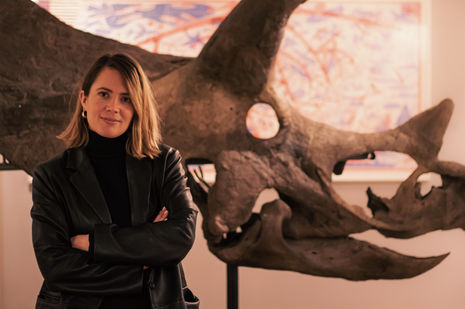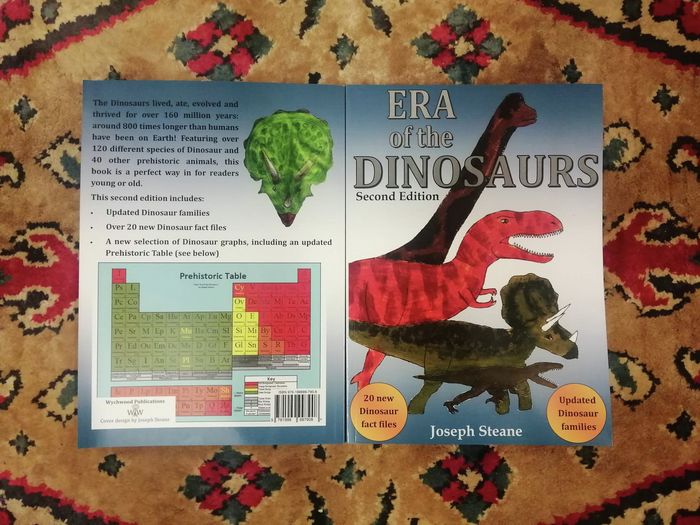When Banksy met a dinosaur: Extraordinary objects in the heart of Cambridge
Ever wondered where you could go to see a triceratops skull next to a Basquiat? As Tomos Davies discovers, the answer may be closer to home than you might think in this review of one of Cambridge’s quirkiest art collections

I have never visited a gallery – or anywhere really – that turns heads quite like Extraordinary Objects. For that, you’ve got Tracy to thank; the 66-million-year-old, £125,000 bisected Triceratops skull watches stoically over Green Street, her ancient form an alien among rows of chic eateries and designer boutiques. Why Tracy? According to director Carla Nizzola, she just gives female energy.
With Carla at its helm, Extraordinary Objects has sought to desegregate the worlds of contemporary art and natural history. Here, modern gems from the likes of Damien Hirst, Bridget Riley and Grayson Perry hang alongside treasures of a prehistoric variety (fossilised T-Rex tooth, anyone?). There’s an absurdity to the place which I just can’t shake off, but Carla’s vision is serious. She is passionate about giving people the opportunity to own something truly extraordinary.
“Fossils are more than quirky interior design”
The gallery is an extension of her personal collection, and she is determined to make fossils and minerals more accessible. Of course, there are significant barriers to entry, but when compared with heritage auction houses, Tracy’s price tag, and others like it, starts to make more sense. Similarly, limited edition prints are designed to afford buyers the opportunity to purchase big-ticket artwork for less money than a family hatchback. Or an Ichthyosaur skeleton. One of those’ll set you back 50 grand.
The commodification of natural history remains a contentious topic. Though Carla is insistent that her pieces are of no scientific value, it is important that public institutions are not priced out of the market as private demand grows. Fossils are more than quirky interior design. In the absence of comprehensive regulation, fossil-hunting has, in many countries, descended into something of an archaeological free-for-all. Professional excavators quarry land at large-scale, resulting in environmental degradation. Carla contends that the benefits of saving natural history from erosion outweigh the ecological costs. I’m not so sure.
“It’s the fusion of contemporary art and palaeontology which makes Extraordinary Objects so unique”
It’s the fusion of contemporary art and palaeontology which makes Extraordinary Objects so unique. I say fusion because, for Carla, the two fields are deeply interwoven. As she explains, in the restoration of ancient specimens, the techniques involved are as creative as they are scientific. In the gallery setting, it is undeniable that the fossils complement the paintings and prints on display. There’s a naive (dare I say child-like?) quality to many of the pieces which juxtaposes the timelessness of natural history. The result is certainly striking, though I must admit I dig the aesthetic. As for Carla’s personal taste, the self-confessed “abstract expressionist nutter” named Jean-Michel Basquiat as a key inspiration, together with recent influences such as Jordy Kerwick and David Shrigley. Their colourful compositions frequently adorn the gallery’s walls.
When people think of art in Cambridge, a few institutions immediately spring to mind. While the Fitzwilliam Museum and Kettle’s Yard are truly incredible spaces, I think it’s right that commercial enterprises are also brought into the conversation. That’s where Extraordinary Objects comes in. In its sheer originality, Carla’s gallery is an immense asset to the town’s cultural scene. She’s worked with other independent galleries to organise arts trails and even lent the Fitzwilliam a Banksy for their recent Defaced! exhibition.
Dealing in dinosaurs can be a risky business. Long-term collaborators with Extraordinary Objects, The Connor Brothers had their own run-in with palaeontology’s shady side when a six-figure Tyrannosaurus skull purchased at an American fossil fair failed to turn up. They suspect the dealer received a better offer, though alternative theories involve high-ranking figures from the Sinaloa cartel. For Carla, the big takeaway was the importance of building trusted relationships, while her time spent as a curator in London equipped her with the skills and contacts needed to carve out a niche in the market. Judging by recent interest in antiquities and natural history, it seems she was on to a winner!
If I’m honest, I had big reservations about the fossil trade, and my interview with Carla didn’t entirely abate them. Though she frames the alternative as skeletons “caged up in museums”, I’m not convinced that private collections are the answer. What I can’t doubt is the buzz she’s created around Extraordinary Objects. The gallery is open to the public (Wednesday – Sunday, 12–5) and has proved a favourite among tourists and students alike. Trust me: it lives up to its name. Tracy’s waiting …
 Comment / Cambridge is right to scrap its state school target1 May 2024
Comment / Cambridge is right to scrap its state school target1 May 2024 News / Academics call for Cambridge to drop investigation into ‘race realist’ fellow2 May 2024
News / Academics call for Cambridge to drop investigation into ‘race realist’ fellow2 May 2024 News / Gender attainment gap to be excluded from Cambridge access report3 May 2024
News / Gender attainment gap to be excluded from Cambridge access report3 May 2024 News / Cambridge postgrad re-elected as City councillor4 May 2024
News / Cambridge postgrad re-elected as City councillor4 May 2024 Comment / Accepting black people into Cambridge is not an act of discrimination3 May 2024
Comment / Accepting black people into Cambridge is not an act of discrimination3 May 2024





